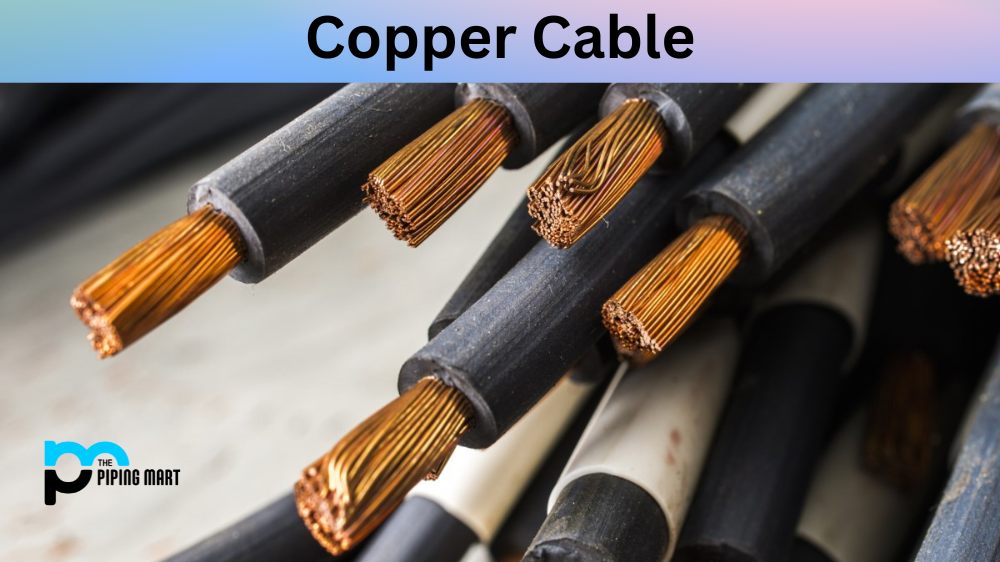Copper cable is a popular choice for wiring in many electrical applications. Copper cable current rating, electrical conductivity and durability make it an ideal choice for carrying current. But how much current can copper cable actually handle? In this blog post, we’ll take a look at the copper cable current carrying capacity.
4 mm Copper Cable Current Carrying Capacity:
4 sq mm cable current capacity
10 sq mm Copper Cable Current Carrying Capacity:
This type of 10 sqmm copper cable current rating has a maximum recommended continuous current rating of 32 amps. It should be noted that 10 sq mm wire current capacity rating applies only to installations in ambient temperatures up to 30°C and with a voltage drop not exceeding 3%.
10 sq mm 3 core copper cable current capacity
The current capacity of a 10 sq mm 3 core copper cable can range from 32 to 73 Amps, depending on the specific cable and application.
35 sq mm Copper Cable Current Carrying Capacity:
35 sq mm cable current capacity has a maximum recommended continuous current rating of 92 amps. Again, this rating applies only to installations in ambient temperatures up to 30°C and with a voltage drop not exceeding 3%.
25 sq mm Copper Cable Current Carrying Capacity:
25 sq mm cable current capacity has a maximum recommended continuous current rating of 63 amps. Once more, 25mm cable amp rating applies only to installations in ambient temperatures up to 30°C and with a voltage drop not exceeding 3%.
50 sq mm Copper Cable Current Carrying Capacity:
50 sq mm copper cable has a maximum recommended continuous current rating of 111 amps. As before, this rating applies only to installations in ambient temperatures up to 30°C and with a voltage drop not exceeding 3%.
16 sq mm Copper Cable Current Carrying Capacity:
16 sq mm copper cable has a maximum recommended continuous current rating of 41 amps. This too applies only to installations in ambient temperatures up to 30°C and with a voltage drop not exceeding 3%.
4sqmm Copper Cable Current Carrying Capacity:
4sqmm copper cable has a maximum recommended continuous current rating of 13amps. Here again, this rating applies only to installations in ambient temperatures up to 30°C and with a voltage drop not exceeding 3%.
70sqmm Copper Cable Current Carring Capacity:
70 sq mm cable current capacity has a maximum recommended continuous current rating of 156amps. As usual, this rating applies only to installations in ambient temperatures up to 30°C and with a voltage drop not exceeding 3%.
95sqmm Copper Cable Current Carring Capacity :
95sqmm copper cable hasa maximum recommended continous current rating of 208amps . Yet again this rating applies only to installations in ambient temperatures up to 30°C and with a voltage drop not exceeding 3%.
4 core 16 sq mm copper cable current carrying capacity
The current carrying capacity (ampacity) of 4 core 16 sq mm copper cable is approximately 61.2 Amps. It’s important to note that this value depends on multiple factors such as surrounding temperature, load duration, and installation conditions.
240 sq mm Copper Cable Current Carring Capacity :
The current carrying capacity of a 240 sq mm copper cable depends on various factors such as the installation method, ambient temperature, and insulation type. Generally, a 240 sq mm copper cable can carry a cable rating from approximately 600 to 800 amperes, depending on these factors. It is important to consult relevant standards and regulations for accurate specification
How to calculate Current carrying capacity of Copper Cable?
Determine the Cross-Sectional Area of the Cable
The first step in calculating the current carrying capacity of a copper cable is to determine its cross-sectional area. This is done by measuring the diameter of the cable and then multiplying it by pi (3.14). The result is the area of the cable in square millimeters. For example, if a cable has a diameter of 8mm, its cross-sectional area would be 25.12 mm2.
Calculate Resistance per Unit Length
The next step is to calculate the resistance per unit length of the cable. This can be done by using Ohm’s Law, which states that resistance equals voltage divided by current (R = V/I). The resistance per unit length is calculated by dividing the voltage (V) by the current (I), multiplied by 1000 to convert it into ohms per kilometer (Ω/km). For example, if a cable has a voltage rating of 300V and an amperage rating of 10A, its resistance per unit length would be 30 Ω/km.
Calculate Current Carrying Capacity
Once you have determined both the cross-sectional area and resistance per unit length of your copper cable, you can calculate its current carrying capacity using Joule’s Law. Joule’s Law states that power equals current squared times resistance (P = I2R). To calculate current carrying capacity, multiply your calculated resistance per unit length with your cross-sectional area in square millimeters and divide it by two (I = 2P/(A x R)). For example, if you have a cable with a cross-sectional area of 25mm2 and a resistance per unit length of 30 Ω/km, its current carrying capacity would be 500A.
Consider Temperature Rating
When calculating current carrying capacity for copper cables, it is important to consider their temperature rating as well. Copper cables are rated according to their maximum operating temperature; higher temperatures require higher ratings for safe operation. Therefore, when selecting a copper cable for your application, make sure that you choose one with an appropriate temperature rating for your environment or application requirements.
Consider Voltage Drop
Finally, when calculating current carrying capacity for copper cables, it is also important to consider voltage drop over distance due to line losses caused by electrical resistivity in cables . Voltage drop occurs when electricity flows through wires; as electricity passes through wires with greater resistivity , more energy is lost as heat resulting in lower voltages at longer distances from source . Therefore , when selecting a copper cable for your application , make sure that you choose one with an appropriate voltage drop rating based on your distance requirements .
How many amps can 2.5 mm cable take?
The current carrying capacity of a 2.5 mm copper cable can vary depending on factors such as installation method, insulation type, and ambient temperature. However, as a general guideline, a 2.5 mm copper cable is typically rated for carrying currents up to 20-25 amps in domestic or residential installations. It is advisable to consult relevant standards and manufacturer specifications for accurate information specific to your application.
Copper Cable Current Carrying Capacity Chart
| Copper cable Current Carrying Capacity | |||
| Cable Size in (Sq. mm) | Single Core | Two Core | Three/Four Core |
| 1 | 17 | 13.5 | 9 |
| 1.5 | 22 | 17.5 | 15.5 |
| 2.5 | 30 | 24 | 21 |
| 4 | 40 | 32 | 28 |
| 6 | 51 | 41 | 36 |
| 10 | 69 | 57 | 50 |
| 16 | 91 | 76 | 68 |
| 25 | 119 | 101 | 89 |
| 35 | 146 | 125 | 110 |
| 50 | 175 | 151 | 134 |
| 70 | 221 | 192 | 171 |
| 95 | 265 | 231 | 201 |
| 120 | 305 | 269 | 239 |
| 150 | 334 | 300 | 261 |
| 185 | 384 | 341 | 296 |
| 240 | 459 | 400 | 346 |
| 300 | 532 | 458 | 394 |
Conclusion:
The amount of amperes (amps) that your cu cable current carrying capacity depends on its size (gauge). By taking into account the size (in square millimeters) of the wire you can determine its ability to safely handle electrical currents. When considering any kind of installation involving electricity, it is important that you consult an experienced electrician who can advise you on the best materials for your specific application – as well as provide you with accurate calculations regarding wattage capacity, copper cable current capacity etc., which will help ensure your safety when dealing with electricity! Intended Audience: Electricians or DIYers interested in understanding the capabilities of different sizes/gauges/shapes/types of electric cables used for wiring projects.

A passionate metal industry expert and blogger. With over 5 years of experience in the field, Palak brings a wealth of knowledge and insight to her writing. Whether discussing the latest trends in the metal industry or sharing tips, she is dedicated to helping others succeed in the metal industry.





I am not sure where you are getting your info, but good topic.
I needs to spend some time learning more or understanding more.
Thanks for excellent info I was looking for this info for my mission.
You’re welcome! I’m glad you found the information helpful. If you have any further questions or need clarification on anything else, feel free to ask. Good luck with your mission!